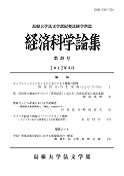島根大学法文学部
ISSN:0387-7310

ダウンロード数 : ? 件
この文献の参照には次のURLをご利用ください : https://ir.lib.shimane-u.ac.jp/2167
経済科学論集 24
1998-03-31 発行
高齢者の世帯状態変化の要因分解 : 1975-1990年
A decomposition of Household Status Transition of Japanese Elderly
廣嶋 清志
ファイル
内容記述(抄録等)
The living arrangements of the Japanese elderly have been steadily shifting from multigenerational one to spouse-oriented one. Accordingly, more and more elderly live in solitary households and institutions in their later life. To know the mechanism of the change in their household, we devised a method using macro-data of the census to decompose net transitions among household types of the elderly into two: one accompanied by marital status change and the other not accompanied by it.
We analyzed the cohort change of household status of the Japanese elderly for the periods, 1975-80, 1980-85, and 1985-90 using the Population Census of Japan and Life table by marital status, made by Institute of Population Problems.
The results show that
1. the net transition rates of one-person household for female aged 75 and over were negative because the net transition rates with marital status change( from married to widowed) were positive but small and the net transition rates without marital status change (pre-sumably mostly to institutions) were large and negative;
2. the total net transitions to couple-only household is a balance between the positive net transitions caused by children's leaving home and the negative net transitions accompanying bereavement. The former is larger for younger old men causing net transitions positive while the latter is larger for women causing net transitions negative;
3. net transitions for the elderly coresiding with their child were negative, to the contrary of our expectation, because of larger negative transitions, apparently caused by their child's leaving home, and very small positive net transitions with marital status change, i.e. mostly from married to widowed. The latter means that on the bereavement Japanese elderly who move in their child's home may be only slightly more than those who move out from coresidence with their child presumably mainly to institutions;
4. net transition rates to institutions were all positive for the elderly of any ages and sexes, and the larger part of them were those without marital status change, which means that the elderly do not move immediately after the bereavement of spouse except for men during the most recent years, 1985-90.
We analyzed the cohort change of household status of the Japanese elderly for the periods, 1975-80, 1980-85, and 1985-90 using the Population Census of Japan and Life table by marital status, made by Institute of Population Problems.
The results show that
1. the net transition rates of one-person household for female aged 75 and over were negative because the net transition rates with marital status change( from married to widowed) were positive but small and the net transition rates without marital status change (pre-sumably mostly to institutions) were large and negative;
2. the total net transitions to couple-only household is a balance between the positive net transitions caused by children's leaving home and the negative net transitions accompanying bereavement. The former is larger for younger old men causing net transitions positive while the latter is larger for women causing net transitions negative;
3. net transitions for the elderly coresiding with their child were negative, to the contrary of our expectation, because of larger negative transitions, apparently caused by their child's leaving home, and very small positive net transitions with marital status change, i.e. mostly from married to widowed. The latter means that on the bereavement Japanese elderly who move in their child's home may be only slightly more than those who move out from coresidence with their child presumably mainly to institutions;
4. net transition rates to institutions were all positive for the elderly of any ages and sexes, and the larger part of them were those without marital status change, which means that the elderly do not move immediately after the bereavement of spouse except for men during the most recent years, 1985-90.
Other Article
